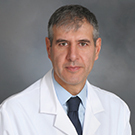Prostate cancer is the most common malignancy in men, making up 29 percent of all male cancer cases in the United States. The encouraging news is that early detection can lead to successful treatment and positive outcomes.
Prostate exams are a first line of defense in the battle against prostate cancer, as they can detect cancer when treatment is most effective, before it has the chance to progress. Regular prostate exams can help significantly improve diagnosis, treatment outcomes and survival rates for prostate cancer patients.
When Should You Get a Prostate Exam?
The recommended age to begin prostate exams varies based on a man’s risk factors, including his age and family history of cancer.
If you’re a man approaching your 40s, or you have a history of cancer in your family, it’s best to discuss your risk factors and screening schedule with a urologist—a doctor who specializes in diseases affecting the kidneys, urinary tract, bladder, prostate and urethra—to determine the best approach for maintaining prostate health.
Below are general recommendations for men regarding when to visit a doctor for a prostate exam:
- Average risk (Ages 45-75): Men at average risk should start annual screenings between the ages of 50 and 55.
- High risk (Ages 40-75): This category includes African American men and those with a family history of prostate cancer, who should consider starting screenings at age 40 or 45, depending on the specific case
Determining Your Risk Factor for Prostate Issues
Certain risk factors are known to increase the chances of a man developing prostate cancer. They include:
- Advancing age
- Having a family history of prostate cancer, especially if a close relative (father or brother) was diagnosed at a younger age (before 65)
- Being of African American descent
- Certain genetic mutations, such as BRCA1 and BRCA2 mutations
- Obesity, poor diet and lack of physical activity
- History of certain prostate conditions or chronic inflammation of the prostate (prostatitis)
- Environmental toxin exposure (such as Agent Orange and exposure to Ground Zero after 9/11)
- Smoking history within 10 years of screening/diagnosis
How Often Should You Get Prostate Exams?
For men at average risk of developing prostate cancer, annual (once yearly) screenings starting at age 50 are typically recommended.
Men who are at higher risk should consider more frequent screenings or screenings at a younger age, such as starting at age 40, which can be determined by a urologist or healthcare provider.
What Happens During a Prostate Exam
Prostate exams are screening procedures that typically include two tests that work together to detect cancer most accurately and keep men healthy.
The prostate exam process generally involves these two main components:
- Prostate Specific Antigen (PSA) blood test: This test measures the level of PSA in the blood. Elevated PSA levels can indicate various prostate conditions, including prostate cancer.
- Digital Rectal Exam (DRE): This is a physical examination in which a healthcare provider inserts a gloved, lubricated finger into the rectum to feel the prostate gland. This allows the doctor to detect any abnormalities in the gland’s size, shape or texture.
What Are They Testing for During a Prostate Exam?
The primary goal of prostate exams is to detect prostate cancer in its early stages. An abnormal PSA level or findings during a DRE can signal that additional tests are needed, such as a prostate biopsy, to confirm or rule out cancer.
What Happens After a Prostate Exam?
After undergoing a prostate exam:
- Screening Results: PSA test and DRE results are usually available within three weeks and help guide doctors in developing personalized recommendations.
- High-Risk Cases: Patients identified as high-risk or with abnormal findings are typically scheduled for further evaluation with urologic oncology specialists. An abnormal finding doesn’t necessarily mean that cancer is present; it’s considered a sign that more testing is needed to determine someone’s risk of prostate problems.
- Intermediate and Low-Risk Patients: Follow-up visits or continued monitoring plans are tailored to meet patients’ health needs and risk profiles. Low-risk patients are usually invited to return to their doctor for another screening in two years, while average-risk patients are usually advised to have a yearly exam.
- Prostate Cancer Diagnosis: If prostate cancer is diagnosed, patients receive comprehensive care from a multidisciplinary team. This includes specialists in urologic oncology, radiation oncology and medical oncology, ensuring appropriate diagnosis, staging, and treatment according to current guidelines.
For more information on prostate exams and scheduling your screening, visit Stony Brook Medicine’s Department of Urology.
Stony Brook Urology’s Prostate Cancer Program offers free screenings throughout the year at various locations across Suffolk County as part of our long-standing commitment to serving at-risk individuals. Our Next Free Prostate Cancer Screening takes place on Wednesday, September 25, 2024. No insurance is required. You can schedule an appointment and learn more here or call (631) 216-9181.
The Stony Brook Cancer Center offers a full spectrum of prostate cancer care, including advanced diagnostics and treatment from a multidisciplinary team of experts. For more information, call (631) 638-1000.













